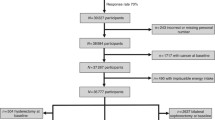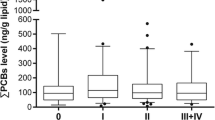Abstract
Studies have suggested that breast cancer risk factor profiles may vary according to joint estrogen receptor (ER) and progesterone receptor (PR) tumor status. Most of the published literature to date which has investigated the association between exposure to organochlorine compounds and breast cancer has reported null or weak associations. If, indeed, the classification by hormonal receptor status identifies different forms of breast cancer, then assessing the risk of exposure to polychlorinated biphenyls (PCBs) on breast cancer as one disease or stratifying based on ER or PR status alone may obscure the association between PCBs and breast cancer. A hospital-based case-control study of 266 cases and 347 benign breast disease controls was conducted to examine the association of blood serum and adipose tissue concentrations of PCBs with breast cancer by joint ER/PR status. Total PCBs were measured in blood serum, and the following PCB congeners were measured in breast adipose tissue: 74, 118, 138, 153, 156, 170, 180, 183, 187. We did not detect any clear relationship or change in breast cancer risk based on joint ER/PR tumor status for body burden of PCBs, whether measured in blood serum or breast adipose tissue, by total PCBs or for specific congeners. These results confirm previous findings in the literature of no positive association between environmental exposure to PCBs and risk of breast cancer.
Similar content being viewed by others
References
Habel LA, Stanford JL. Hormone receptors and breast cancer. Epidemiol Rev 1993; 15: 209–219.
Potter JD, Cerhan JR, Sellers TA, et al. Progesterone and estrogen receptors and mammary neoplasia in the Iowa Women's Health Study: how many kinds of breast cancer are there? Cancer Epidem Biomar Prev 1995; 4: 319–326.
Clark GM, McGuire WL, Hubay CA, et al. Progesterone receptors as a prognostic factor in Stage II breast cancer. New Engl J Med 1983; 309: 1343–1347.
Horwitz KB. The central role of progesterone receptors and progestational agents in the management and treatment of breast cancer. Semin Oncol 1988; 15: 14–19.
Yoo KY, Tajima K, Miura S, et al. Breast cancer risk factors according to combined estrogen and progesterone receptor status: a case-control analysis. Am J Epidemiol 1997; 146: 307–314.
Huang WY, Newman B, Millikan RC, et al. Hormonerelated factors and risk of breast cancer in relation to estrogen receptor and progesterone receptor status. Am J Epidemiol 2000; 151: 703–714.
Britton JA, Gammon MD, Schoenberg JB, et al. Risk of Breast Cancer Classified by Joint Estrogen Receptor and Progesterone Receptor Status among Women 20-44 Years of Age. Am J Epidemiol 2002; 156: 507–516.
Mussalo-Rauhamaa H. Selenium and DDE in breast fat of breast cancer patients: their relationship to hormone receptors in breast tissue. JNCI 1993; 85: 1964–1965.
Wolff MS, Toniolo PG, Lee EW, et al. Blood levels of organochlorine residues and risk of breast cancer [see comments]. J Natl Cancer Inst 1993; 85: 648–652.
Moysich KB, Ambrosone CB, Vena JE, et al. Environmental organochlorine exposure and postmenopausal breast cancer risk. Cancer Epidem Biomar Prev 1998; 7: 181–188.
Moysich KB, Shields PG, Freudenheim JL, et al. Polychlorinated biphenyls, cytochrome P4501A1 polymorphism, and postmenopausal breast cancer risk. Cancer Epidem Biomar Prev 1999; 8: 41–44. 799
Hoyer AP, Grandjean P, Jorgensen T, et al. Organochlorine exposure and risk of breast cancer. Lancet 1998; 352: 1816–1820.
Hoyer AP, Gerdes AM, Jorgensen T, et al. Organochlorines, p53 mutations in relation to breast cancer risk and survival. A Danish cohort-nested case-control study. Breast Cancer Res Tr 2002; 71: 59–65.
Hoyer AP, Jorgensen T, Grandjean P, et al. Repeated measurements of organochlorine exposure and breast cancer risk (Denmark). Cancer Cause Control 2000; 11: 177–184.
Aronson KJ, Miller AB, Woolcott CG, et al. Breast adipose tissue concentrations of polychlorinated biphenyls and other organochlorines and breast cancer risk. Cancer Epidem Biomar Prev 2000; 9: 55–63.
Demers A, Ayotte P, Brisson J, et al. Risk and aggressiveness of breast cancer in relation to plasma organochlorine concentrations. Cancer Epidem Biomar Prev 2000; 9: 161–166.
Sierra-Santoyo A, Hernandez M, Albores A, et al. Sexdependent regulation of hepatic cytochrome P-450 by DDT. Toxicol Sci 2000; 54: 81–87.
Falck F, Jr., Ricci A, Jr., Wolff MS, et al. Pesticides and polychlorinated biphenyl residues in human breast lipids and their relation to breast cancer. Arch Environ Health 1992; 47: 143–146.
Wolff MS, Zeleniuch-Jacquotte A, Dubin N, et al. Risk of breast cancer and organochlorine exposure. Cancer Epidem Biomar Prev 2000; 9: 271–277.
Krieger N, Wolff MS, Hiatt RA, et al. Breast cancer and serum organochlorines: a prospective study among white, black, and Asian women [see comments]. J Natl Cancer Inst 1994; 86: 589–599.
Hunter DJ, Hankinson SE, Laden F, et al. Plasma organochlorine levels and the risk of breast cancer [see comments]. New Engl J Med 1997; 337: 1253–1258.
Hoyer AP, Jorgensen T, Rank F, et al. Organochlorine exposures influence on breast cancer risk and survival according to estrogen receptor status: a Danish cohort-nested case-control study. BMC Cancer 2001; 1: 8.
Dorgan JF, Brock JW, Rothman N, et al. Serum organochlorine pesticides and PCBs and breast cancer risk: results from a prospective analysis (USA). Cancer Cause Control 1999; 10: 1–11.
Zheng T, Holford TR, Mayne ST, et al. Risk of female breast cancer associated with serum polychlorinated biphenyls and 1,1-dichloro-2,2'-bis(p-chlorophenyl) ethylene. Cancer Epidem Biomar Prev 2000; 9: 167–174.
Zheng T, Holford TR, Tessari J, et al. Breast cancer risk associated with congeners of polychlorinated biphenyls. Am J Epidemiol 2000; 152: 50–58.
Helzlsouer KJ, Alberg AJ, Huang HY, et al. Serum concentrations of organochlorine compounds and the subsequent development of breast cancer. Cancer Epidem Biomar Prev 1999; 8: 525–532.
Ward EM, Schulte P, Grajewski B, et al. Serum organochlorine levels and breast cancer: a nested casecontrol study of Norwegian women. Cancer Epidem Biomar Prev 2000; 9: 1357–1367.
Millikan R, DeVoto E, Duell EJ, et al. Dichlorodiphenyldichloroethene, polychlorinated biphenyls, and breast cancer among African-American and white women in North Carolina. Cancer Epidem Biomar Prev 2000; 9: 1233–1240.
Stellman SD, Djordjevic MV, Dritton JA, et al. Breast cancer risk in relation to adipose concentrations of organochlorine pesticides and polychlorinated biphenyls in Long Island, New York. Cancer Epidem Biomar Prev 2000; 9: 1241–1249.
Woolcott CG, Aronson KJ, Hanna WM, et al. Organochlorines and breast cancer risk by receptor status, tumor size, and grade (Canada). Cancer Cause Control 2001; 12: 395–404.
Laden F, Hankinson SE, Wolff MS, et al. Plasma organochlorine levels and the risk of breast cancer: an extended follow-up in the Nurses' Health Study. Int J Cancer 2001; 91: 568–574.
Gammon MD, Wolff MS, Neugut AI, et al. Environmental toxins and breast cancer on Long Island. II. Organochlorine compound levels in blood. Cancer Epidem Biomar Prev 2002; 11: 686–697.
Demers A, Ayotte P, Brisson J, et al. Plasma concentrations of polychlorinated biphenyls and the risk of breast cancer: a congener-specific analysis. Am J Epidem 2002; 155: 629–635.
Dewailly E, Dodin S, Verreault R, et al. High organochlorine body burden in women with estrogen receptor-positive breast cancer. J Natl Cancer Inst 1994; 86: 232–234.
Environmental Protection Agency. Polychlorinated Biphenyls. October 28, 2003, Available at: http://www. epa.gov/opptintr/pcb. Accessed November 11, 2003.
Murphy R, Harvey C. Residues and metabolites of selected persistent halogenated hydrocarbons in blood specimens from a general population survey. Environ Health Persp 1985; 60: 115–120.
Adami HO, Lipworth L, Titus-Ernstoff L, et al. Organochlorine compounds and estrogen-related cancers in women. Cancer Cause Control 1995; 6: 551–566.
Stanford JL, Szklo M, Boring CC, et al. A case-control study of breast cancer stratified by estrogen receptor status. Am J Epidem 1987; 125: 184–194.
Rayter Z. Steroid receptors in breast cancer. Brit J Surg 1991; 78: 528–535.
Zheng T, Holford TR, Mayne ST, et al. DDE and DDT in breast adipose tissue and risk of female breast cancer. Am J Epidem 1999; 150: 453–458.
Archibeque-Engle SL, Tessari JD, Winn DT, et al. Comparison of organochlorine pesticide and polychlorinated biphenyl residues in human breast adipose tissue and serum. J Toxicol Env Health 1997; 52: 285–293.
McCarty KS, Jr., Miller LS, Cox EB, et al. Estrogen receptor analyses. Correlation of biochemical and immunohistochemical methods using monoclonal antireceptor antibodies. Arch Pathol Lab Med 1985; 109: 716–721.
SAS Institute SAS/STAT User's Guide. Version 6. Cary, NC: SAS Institute, 1990.
Wolff MS, Camann D, Gammon M, Stellman SD. Proposed PCB congener groupings for epidemiological studies [letter]. Environ Health Persp 1997; 105: 13–14.
Safe S. Toxicology, structure-function relationship, and human and environmental health impacts of poly-800 chlorinated biphenyls: progress and problems. Environ Health Persp 1992; 100: 259–268.
Wolff MS, Toniolo PG. Environmental organochlorine exposure as a potential etiologic factor in breast cancer. Environ Health Persp 1995; 103: 141–145.
Kelsey JL. Breast cancer epidemiology: summary and future directions. Epidemiol Rev 1993; 15: 256–263.
Holford TR, Zheng T, Mayne ST, et al. Joint effects of nine polychlorinated biphenyl (PCB) congeners on breast cancer risk. Int J Epidemiol 2000; 29: 975–982.
Colditz GA, Rosner BA, Chen WY, Holmes MD, Hankinson SE. Risk factors for breast cancer according to estrogen and progesterone receptor status JNCI 96; 2004: 218–228.
Author information
Authors and Affiliations
Rights and permissions
About this article
Cite this article
Rusiecki, J.A., Holford, T.R., Zahm, S.H. et al. Polychlorinated Biphenyls and Breast Cancer Risk by Combined Estrogen and Progesterone Receptor Status. Eur J Epidemiol 19, 793–801 (2004). https://doi.org/10.1023/B:EJEP.0000036580.05471.31
Issue Date:
DOI: https://doi.org/10.1023/B:EJEP.0000036580.05471.31




